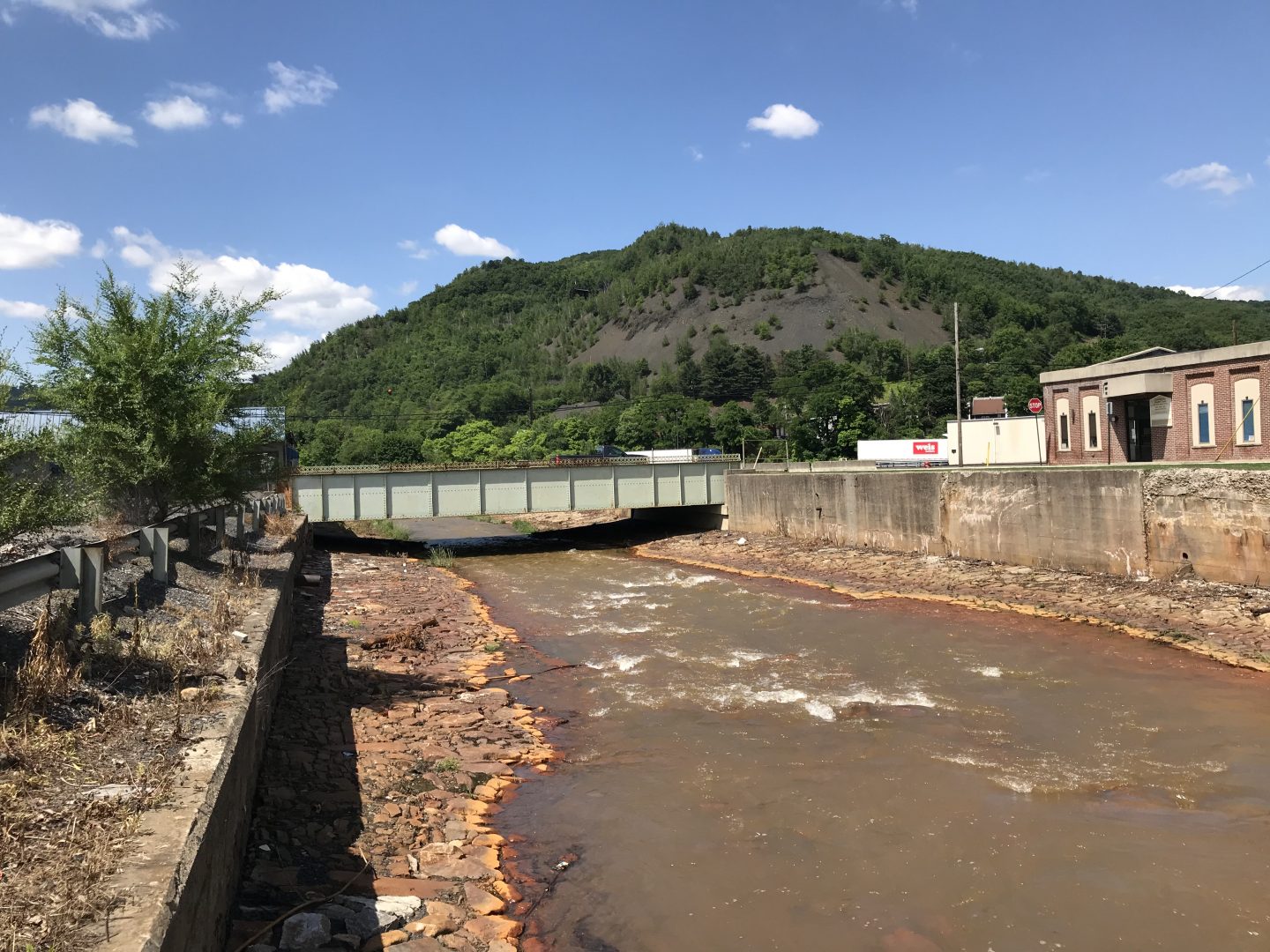
FILE PHOTO: (Shamokin, Northumberland County) Shamokin Creek is colored orange from acid mine drainage. In the background, a mountain of waste coal towers over the town.
Marie Cusick/ StateImpact Pennsylvania


FILE PHOTO: (Shamokin, Northumberland County) Shamokin Creek is colored orange from acid mine drainage. In the background, a mountain of waste coal towers over the town.
Marie Cusick/ StateImpact Pennsylvania

Marie Cusick/ StateImpact Pennsylvania
FILE PHOTO: (Shamokin, Northumberland County) Shamokin Creek is colored orange from acid mine drainage. In the background, a mountain of waste coal towers over the town.
Listen to the story:
People across the commonwealth can weigh in on the state’s new environmental justice policy.
The Department of Environmental Protection started revising the policy under the Wolf Administration.
Now, the Shapiro Administration is rolling out an “interim final” policy and collecting public comment before enacting it.
Pennsylvania’s previous environmental justice policies allowed for more public hearings and engagement in EJ areas when a company applied for a permit to release pollution.
But it was largely toothless. It offered no added safeguards for those communities and was only used internally by the DEP.
The new policy is still internal to DEP, but it provides more guidance for considering EJ areas when holding hearings, issuing permits, and levying fines. The policy can be read on DEP’s website.
Environmental justice areas had been defined as any census tract where at least 20 percent of people live at or below the federal poverty line or at least 30 percent identify as a non-white minority. About 4 million Pennsylvanians live in EJ areas.
But now, DEP is using a new screening tool to define which places are EJ areas. The PennEnviroScreen tool gives each area of the state a score based on its pollution burden and population characteristics. Areas with a large amount of pollution and sensitive groups have higher scores. Places that score in the 80th percentile and above are considered EJ areas.
Public hearings are scheduled in Ranshaw, Scranton, Erie, Pittsburgh, Harrisburg, Chester, and Philadelphia. Two virtual hearings are also scheduled.
People who want to speak at the hearings are asked to register ahead of time at DEP’s website.
Written comments can be sent using DEP’s eComment tool or by e-mailing ecomment@pa.gov. They can also be mailed to the Technical Guidance Coordinator, Department of Environmental Protection, Policy Office, Rachel Carson State Office Building, P.O. Box 2063, Harrisburg, PA 17105-2063.
The comment period closes October 29.
Full hearing schedule:
Wednesday, October 11, 2023, 5 p.m. – 7 p.m. Virtual
Thursday, October 12, 2023, 6 p.m. – 8 p.m., Ranshaw, PA
Brady Fire Company (Banquet Hall)
700 Maple Street
Ranshaw, PA 17866
Monday, October 16, 2023, 6 p.m. – 8 p.m., Scranton, PA
University of Scranton
Loyola Science Center
200 Monroe Avenue, Room 133
Scranton, PA 18510
Wednesday, October 18, 2023, 6 p.m. – 8 p.m., Erie, PA
Erie Center for Arts & Technology
Ada Lawrence Community Room
650 East Avenue
Erie, PA 16503
Wednesday, October 18, 2023, 6 p.m. – 7:30 p.m., Pittsburgh, PA
North Side Institution COGIC
Banquet Hall
302 West North Avenue
Pittsburgh, PA 15212
Thursday, October 19, 2023, 6 p.m. – 8 p.m., Harrisburg, PA
YMCA Camp Curtin
2135 North Sixth Street
Harrisburg, PA 17110
Saturday, October 21, 2023, 10 a.m. – 12 p.m., Chester, PA
ACCESS Community Center
701 Booth Street
Chester, PA 19013
Wednesday, October 25, 5 p.m. – 7 p.m., Virtual
Thursday, October 26, 2023, 6 p.m. – 8 p.m., Philadelphia, PA
Drexel University | Anthony J. Drexel Picture Gallery, Main Building, Third Floor
3141 Chestnut Street
Philadelphia, PA 19104
StateImpact Pennsylvania is a collaboration among WITF, WHYY, and the Allegheny Front. Reporters Reid Frazier, Rachel McDevitt and Susan Phillips cover the commonwealth’s energy economy. Read their reports on this site, and hear them on public radio stations across Pennsylvania.
(listed by story count)
StateImpact Pennsylvania is a collaboration among WITF, WHYY, and the Allegheny Front. Reporters Reid Frazier, Rachel McDevitt and Susan Phillips cover the commonwealth’s energy economy. Read their reports on this site, and hear them on public radio stations across Pennsylvania.
Climate Solutions, a collaboration of news organizations, educational institutions and a theater company, uses engagement, education and storytelling to help central Pennsylvanians toward climate change literacy, resilience and adaptation. Our work will amplify how people are finding solutions to the challenges presented by a warming world.